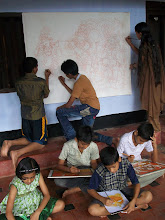Rupabhedāh pramānāni bhāva lāvanya yojanam I
Sādrisya varnikābhanga iti citra shad-angakam II
rupa-bheda, or the distinction of forms and appearances.E. B. Havell (he inspired artists like Nandalal Bose to travel to Ajanta to re discover our art heritage) draws a parallel to the famous parable in which Arjuna, on being asked by his teacher Drona to describe the bird to be struck down, replied that he saw only the bird’s head .
mind’s eye:rupa-bheda is like the revelation of the divine or Sruti
while the remaining five principles, namely, proportion, expression, beauty, resemblance, and use of material are like Smriti, the knowledge of which is handed down by tradition:
Pramânam, which stands for measurement, proportions etc have been dealt with in various other Silpasâstras. Sukraniti, lays down that one should design for all the limbs a grace that is suited to it. In Mayâsâstra and Pratimâmana -Laksanam, a great deal of importance is given to the eyes and to the proportions of other limbs. According to Sukraniti, an image made as per the principles laid down by Silpasâstras is beautiful.
The principles of bhâva and lâvanya yojanam, that is, feeling and beauty or grace are linked to the heart or soul of the artist. Intense devotion on the part of the artist finds its expression in terms of bhâva and lâvanya yojanam.
varnikābhanga is understood in terms of the use of the medium or tools.
Sādrisya is not imitation, but rather as what bears a reference to something in the world of senses, in the phenomenal world
The artist, through a process of severe mental discipline, is taught to discriminate the essentials in forms and appearances, and to see clearly with his mind’s eye before he takes up brush or chisel.
skip to main |
skip to sidebar

Dhyanasankalpam is an Openstudio for Indian (Kerala) murals,and here we regard the pursuit of pure aesthetic experience,as Yoga. Its an exalted experience not just for the individual artist but for the whole community and even humanity, that which touches and consorts with every aspect of Indian life. We at Dhyanasankalpam create works that would last a millennium or two if not for posterity, like the murals of Ajanta.All that you have to ensure for us are walls that would last just as long.
Followers
Blog Archive
-
▼
2010
(53)
-
▼
February
(17)
- Day 8 at ' the flute recital'
- Beauty is the eye discovering in our world what th...
- Where have all the murals gone?
- Poetry and painting,
- Islam and Painting
- Dharana-Dhyaana-Samadhi:from Patanjali’s Yoga Sutra
- the rasika (connoisseur)
- The Artist
- Time and Memory in Art:
- Pratibha: in Indian Poetics
- Some Important Aesthetic Concepts:
- Rasa theory:
- The rasa -experience- 'rasaanubhuti'
- Yashodhara ‘s ‘Shad-anga’ :the six limbs of the ar...
- Essential nature of Indian Art
- ‘A master artist has also to be a master technician’
- Writers on Aesthetics (with focus on Poetics) of A...
-
▼
February
(17)
Our mission

- Dhyanasankalpam
- calicut, kerala, India
- The ageless sense of Indian aesthetics or concept of beauty,is reflected in Indian Murals.It is an open activity.It is team work and also a community based art form.DhyanaSankalpam -an Openstudio for Kerala Murals attempts to uphold the ageless traditions.